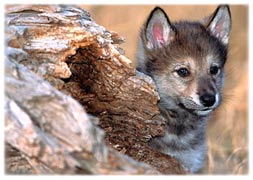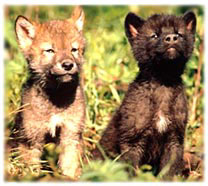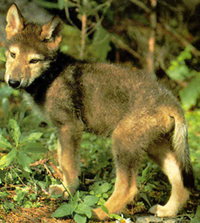The Raising of the Pups

The juvenile cubs leave their den and follow the adults to the area where they are presently hunting and a temporary den is set up for the cubs there. This den is the wolves' so called rendezvous site. It is where the hunting wolves return from their trips to bring food for the waiting youngsters. It has the advantage of being closer to wherever the adults are hunting, which can be over 30 kilometres (20 miles) from the original den, so that returning to the cubs is easier. Sometimes the wolves on a hunt call the cubs to their kill if it is substantial, like a moose, rather than dismember and carry the pieces miles to the cubs. This place might then turn into a new rendezvous site.
The wolves typically make a rendezvous site where there is some cover, like a thicket, boulders or an opening in the ground, so long as it is big enough to accommodate all the cubs. One of the adults watches over the cubs at the site while the other adults are away hunting. The cubs explore their surrounds and the site gradually fills with their scats, chewed bones and worn down trails leading all around. At other times the cubs sleep or doze on top of each other to keep warm while waiting for the returning hunters.

When the adults set off on a hunt, the juveniles tag along as far as they can before giving up and going home. Eventually they manage to keep up with the adults all the way. This is when they start taking part on the hunt and abandon the rendezvous site. A late developing or sick cub, however, may be left behind. An adult will bring the cub food from time to time, but visits drop off as the pack hunts increasingly further away and the cub will die unless he can make good.
Whether a young wolf decides to stay or leave the pack depends on the
interplay of several factors. An important determinant is wolf density and,
related to it,  the availability of vacant space for a territory. In a region
saturated with wolves there will be no free space. Young wolves may make forays
into the surrounds or make more sustained efforts but fail to get a foothold
somewhere and return home. If accepted back they may postpone leaving home again
until the situation changes.
Prey availability is another important element. When food is limited the parents
insure their cubs of the year feed before their older offspring get their fill.
Their grown offspring then have a strong stimulus to leave the pack and fend for
themselves if they are to get enough food. This feeding order was well made by
David Mech in his book The Wolves of Denali (David Mech as made many other findings,
that you can find at other sites).
He inspected the remains of four wolves
trappers had caught. As they were trapped in the same part of his study area they were
presumably from the same pack: an adult male, two cubs and a yearling. The former were
well covered with fat but the yearling was scrawny.
the availability of vacant space for a territory. In a region
saturated with wolves there will be no free space. Young wolves may make forays
into the surrounds or make more sustained efforts but fail to get a foothold
somewhere and return home. If accepted back they may postpone leaving home again
until the situation changes.
Prey availability is another important element. When food is limited the parents
insure their cubs of the year feed before their older offspring get their fill.
Their grown offspring then have a strong stimulus to leave the pack and fend for
themselves if they are to get enough food. This feeding order was well made by
David Mech in his book The Wolves of Denali (David Mech as made many other findings,
that you can find at other sites).
He inspected the remains of four wolves
trappers had caught. As they were trapped in the same part of his study area they were
presumably from the same pack: an adult male, two cubs and a yearling. The former were
well covered with fat but the yearling was scrawny.
